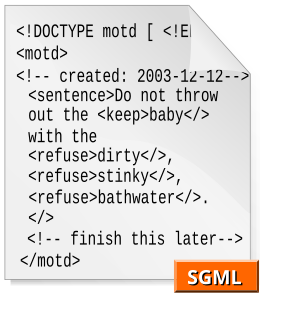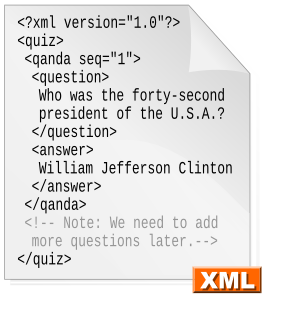
Hypertext Markup Language (HTML) is the standard markup language for documents designed to be displayed in a web browser. It can be assisted by technologies such as Cascading Style Sheets (CSS) and scripting languages such as JavaScript.

In computer text processing, a markup language is a system for annotating a document in a way that is syntactically distinguishable from the text, meaning when the document is processed for display, the markup language is not shown, and is only used to format the text. The idea and terminology evolved from the "marking up" of paper manuscripts, which is traditionally written with a red or blue pencil on authors' manuscripts. Such "markup" typically includes both content corrections, and also typographic instructions, such as to make a heading larger or boldface.

The Standard Generalized Markup Language is a standard for defining generalized markup languages for documents. ISO 8879 Annex A.1 states that generalized markup is "based on two postulates":

Extensible Markup Language (XML) is a markup language that defines a set of rules for encoding documents in a format that is both human-readable and machine-readable. The World Wide Web Consortium's XML 1.0 Specification of 1998 and several other related specifications—all of them free open standards—define XML.

Configuration management (CM) is a systems engineering process for establishing and maintaining consistency of a product's performance, functional, and physical attributes with its requirements, design, and operational information throughout its life. The CM process is widely used by military engineering organizations to manage changes throughout the system lifecycle of complex systems, such as weapon systems, military vehicles, and information systems. Outside the military, the CM process is also used with IT service management as defined by ITIL, and with other domain models in the civil engineering and other industrial engineering segments such as roads, bridges, canals, dams, and buildings.
In computing, AAP DTD is a set of three SGML Document Type Definitions for scientific documents, defined by the Association of American Publishers. It was ratified as a U.S. standard under the name ANSI/NISO Z39.59 in 1988, and evolved into the international ISO 12083 standard in 1993. It was supplanted as a U.S. standard by ANSI/ISO 12083 in 1995.
The Organization for the Advancement of Structured Information Standards (OASIS) is a global nonprofit consortium that works on the development, convergence, and adoption of open standards for security, Internet of Things, energy, content technologies, emergency management, and other areas.
A United States defense standard, often called a military standard, "MIL-STD", "MIL-SPEC", or (informally) "MilSpecs", is used to help achieve standardization objectives by the U.S. Department of Defense.
Integrated logistic support (ILS) is an integrated and iterative process for developing materiel and a support strategy that optimizes functional support, leverages existing resources, and guides the system engineering process to quantify and lower life cycle cost and decrease the logistics footprint, making the system easier to support. Although originally developed for military purposes, it is also widely used in commercial product support or customer service organisations.
S1000D is an international specification for the procurement and production of technical publications. It is an XML specification for preparing, managing, and publishing technical information for a product. It was initially developed by the AeroSpace and Defence Industries Association of Europe (ASD) for use with military aircraft. Since Issue 2 the scope has been extended to include land, sea and even non-equipment products. It is widely used in civil as well as military products. S1000D is part of the S-Series of ILS specifications.
An IETM or Interactive Electronic Technical Manual is a portal to manage technical documentation. IETMs compress volumes of text into just CD-ROMs or online pages which may include sound and video, and allow readers to locate needed information far more rapidly than in paper manuals. IETMs came into widespread use in the 1990s as huge technical documentation projects for the aircraft and defense industries.
CALS is a United States Department of Defense initiative for electronically capturing military documentation and linking related information.
Extensible Forms Description Language (XFDL) is a high-level computer language that facilitates defining a form as a single, stand-alone object using elements and attributes from the Extensible Markup Language (XML). Technically, it is a class of XML originally specified in a World Wide Web Consortium (W3C) Note. See Specifications below for links to the current versions of XFDL. XFDL It offers precise control over form layout, permitting replacement of existing business/government forms with electronic documents in a human-readable, open standard.
Logistics Support Analysis (LSA) is a structured approach to increase efficiency of maintenance and reduces the cost of providing support by preplanning all aspects of Integrated Logistics Support. A successful LSA will define those support requirements that are ideal for the system design.
Technical documentation is used in many areas of the everyday life. Nearly everything has to be provided with at minimum a drawing including a few locators. The product liability and many other issues regarding consumer protection have to be covered inside technical documentation. A special form of technical documentation is electronic technical documentation, a further subform is interactive electronic technical documentation (IETD). The complexity of IETD especially regarding the huge mass of data elements, their linkage and the version management issuing and release process must be controlled via a special document management system. To handle these complex structures of ASD S1000D IETDs, the Common Source Data Base is necessary.

Electrical or fiber-optic connectors used by U.S. Department of Defense were originally developed in the 1930s for severe aeronautical and tactical service applications, and the Type "AN" (Army-Navy) series set the standard for modern military circular connectors. These connectors, and their evolutionary derivatives, are often called Military Standard, "MIL-STD", or (informally) "MIL-SPEC" or sometimes "MS" connectors. They are now used in aerospace, industrial, marine, and even automotive commercial applications.
Election Markup Language (EML) is an XML-based standard to support end to end management of election processes.
The MIL-STD-883 standard establishes uniform methods, controls, and procedures for testing microelectronic devices suitable for use within military and aerospace electronic systems including basic environmental tests to determine resistance to deleterious effects of natural elements and conditions surrounding military and space operations; mechanical and electrical tests; workmanship and training procedures; and such other controls and constraints as have been deemed necessary to ensure a uniform level of quality and reliability suitable to the intended applications of those devices. For the purpose of this standard, the term "devices" includes such items as monolithic, multichip, film and hybrid microcircuits, microcircuit arrays, and the elements from which the circuits and arrays are formed. This standard is intended to apply only to microelectronic devices.
Steven J DeRose is a computer scientist noted for his contributions to Computational Linguistics and to key standards related to document processing, mostly around ISO's Standard Generalized Markup Language (SGML) and W3C's Extensible Markup Language (XML).





